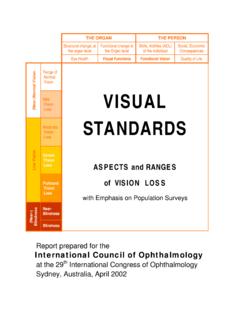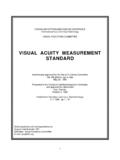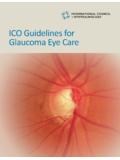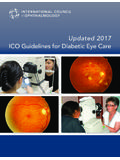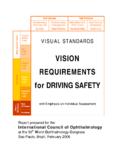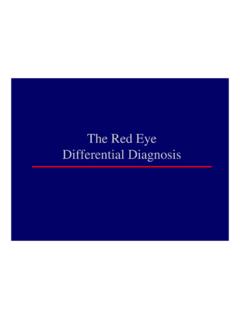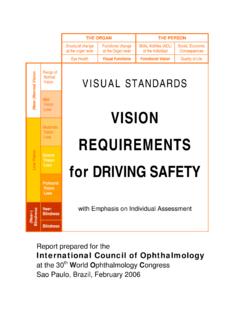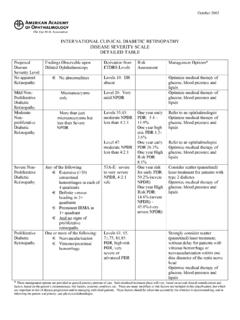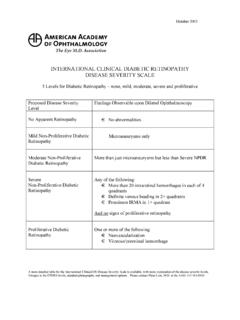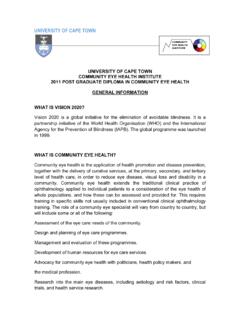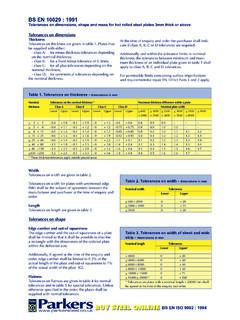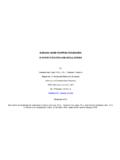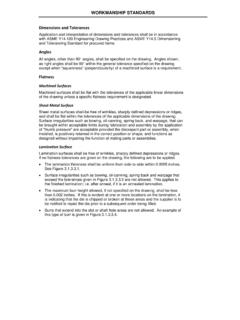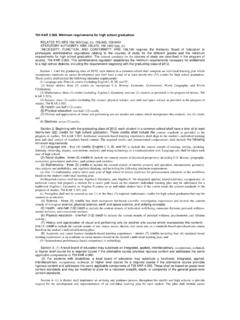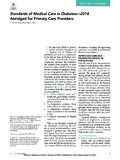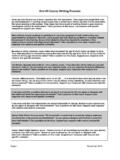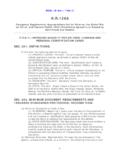Transcription of VISUAL STANDARDS - International Council of …
1 THE ORGANTHE PERSONS tructural change, atthe organ levelFunctional change atthe Organ levelSkills, Abilities (ADL)of the individualSocial, EconomicConsequencesEye HealthVisual FunctionsFunctional VisionQuality of LifeRange of Normal Vision(Near-)Normal VisionMild Vision LossModerate Vision LossSevere Vision LossLow VisionProfound Vision LossNear-Blindness(Near-)BlindnessBlindn essVISUALSTANDARDSASPECTS and RANGESof VISION LOSS with Emphasis on Population Surveys Report prepared for the International Council of Ophthalmology at the 29th International Congress of Ophthalmology Sydney, Australia, April 2002 Resolution adopted by the International Council of OphthalmologySydney, Australia, April 20, 2002 (1)
2 WHEREAS lack of clarity about the appropriate use of the term Blindness has led to confusion about itsdefinition and to varying reports about its prevalence and incidence andWHEREAS the mission of ophthalmology and the International Council of Ophthalmology is not limited to theprevention of blindness, but also includes the prevention and remediation of lesser levels of vision loss, whichdo not fit under the term blindness ,THEREFORE, be it resolved that the International Council of Ophthalmology, at its meeting in Sydney,Australia, April 2002(A)Recommends to the World Vision Community the use of the following terminology (2): Blindness to be used only for total vision loss and for conditions where individuals have to relypredominantly on vision substitution skills.
3 Low Vision to be used for lesser degrees of vision loss, where individuals can be helped significantly byvision enhancement aids and devices. VISUAL Impairment to be used when the condition of vision loss is characterized by a loss of visualfunctions (such as VISUAL acuity, VISUAL field, etc.) at the organ level. Many of these functions can bemeasured quantitatively. Functional Vision to be used to describe a person s ability to use vision in Activities of Daily Living(ADL). Presently, many of these activities can be described only qualitatively. Vision Loss to be used as a general term, including both total loss (Blindness) and partial loss (LowVision), characterized either on the basis of VISUAL impairment or by a loss of functional vision.
4 (B)For reporting the prevalence of vision loss in population studies and clinical research, reconfirms itsearlier recommendation (Kyoto, 1978) to describe vision loss in more detail by classifying it intomultiple Ranges of Vision Loss (based on VISUAL acuity): Normal vision>= Mild vision loss< >= Moderate vision loss< >= Severe vision loss< >= Profound vision loss< >= Near-total vision loss (near blindness)< >= NLP Total vision loss (total blindness NLP Recommends that, where such detailed reporting is not feasible, the categories defined in ICD-9 andICD-10 of the World Health Organization be used as a minimum: Low Vision< >= Blindness< NLPwith additional detail where feasible.)
5 (C)Recommends with reference to its VISUAL Acuity Measurement Standard (Kos, 1984), That the ETDRS protocol of the National Eye Institute, National Institutes of Health, USA, be adopted asthe ' gold standard" for VISUAL acuity measurement in population studies and clinical ETDRS charts are characterized by a proportional layout and a geometric) progression of letter sizes. That deviations from that protocol be spelled out if adherence to the complete protocol is not feasible. That the geometric progression be maintained to assure equal accuracy at all levels of vision loss, evenif the full proportional layout is not feasible (as in projector charts).
6 It is recognized that the use of the full ETDRS charts is often not practical in present clinical practice. That measurement conditions be specified, including (but not limited to) whether best-corrected acuity,presenting acuity, pinhole acuity, distance and/or near acuity are functional importance of near acuity is (1) A full discussion of the rationale behind these recommendations can be found in the ICO report VISUAL STANDARDS Aspects and Ranges of Vision Loss, with emphasis on PopulationSurveys , prepared by August Colenbrander, MD, for the 2002 report can be downloaded from the ICO web site: (2)This terminology does not preclude the possibility that the VISUAL condition could subsequently beimproved by medical, refractive or surgical of CONTENTSS ections1 Executive SummaryPage 22 Aspects of Vision Loss 43 Ranges of VISUAL Acuity Loss 64 Ranges of Ability Loss 85 VISUAL Acuity and Reading Ability106 Ranges of VISUAL Field Loss127 VISUAL Acuity Measurement148 Reporting of Survey Results, Terminology16 Appendices1 Editorial, American Journal of Ophthalmology182 Aspects of Vision Loss203 Ranges of VISUAL Acuity Loss224 Ranges of Ability Loss245 VISUAL Acuity and Reading Ability256 The Functional Vision Score (FVS)
7 System267 VISUAL Acuity Measurement278 Reporting and Interpretation of Survey Results29 References30 Summary Table32 Please direct COMMENTS to the author:August Colenbrander, MD Affiliate Senior Scientist, Smith-Kettlewell Eye Research Institute, San Francisco Director Emeritus, Low Vision Services, California Pacific Medical Center Correspondence:664 Atherton AvenueNovato, CA 94945-2605 USA Phone:+1-415-209-9529 Fax:+1-415-209-9429 The report can be downloaded in PDF FORMAT from the website of the International Council ofOphthalmology: HARD COPIES are available from the Pacific Vision Foundation, San donation of $ per copy is requested for shipping and Fax the request to +1-415-346-6562or e-mail to: mention quantity, shipping address and a credit card number with expiration STANDARDS Aspects and Ranges of Vision LossICO report Sydney, April 20022 SECTION 1 EXECUTIVE SUMMARYS tatistics and surveys about the prevalence and incidence of vision loss are available frommany different sources.
8 Comparing the data is often hindered by a lack of uniform goal of this report is to give a voice to emerging areas of consensus by providing guidelinesfor the uniform use of definitions, measurements and reporting report was compiled at the request of the International Council of Ophthalmology (ICO) andtheir Vision for the Future plan and in cooperation with the World Health Organization (WHO),the International Agency for the Prevention of Blindness (IAPB) and their joint project Vision2020 the Right to Sight .Preservation of Vision or Prevention of BlindnessRecent decades have seen a gradual extension in the goals of population surveys from a studyof the causes of truly blinding eye diseases to a study of lesser levels of vision loss and theirsocial and economic consequences.
9 These lesser levels of loss no longer fit under the term blindness . This shift is acknowledged in the project title of Vision 2020 the Right to Sight and in the recent publication of the International Council of Ophthalmology and the AcademiaOphthalmologica Internationalis: Vision for the Future a Strategic Plan to Preserve andRestore Vision .Appendix 1 contains the text of an editorial on this topic that appeared in the February 2002issue of the American Journal of Ophthalmology. The sections that follow discuss a unifiedframework for reporting both aspects and ranges of vision loss, as summarized in Table 2 Aspects of Vision LossMost events or conditions can be approached from different points of view.
10 Thus, differentobservers will see different aspects. Some will see a glass as half empty, that others may seeas half full. If these differences are not acknowledged, miscommunications may bring order among the many possible points of view when discussing the causes andconsequences of Vision Loss, it is helpful to distinguish four main aspects of vision loss, as hasbeen done in the WHO International Classification of Impairments, Disabilities and Handicaps(ICIDH-80, 1980) and its successor the WHO International Classification of Function, Disabilityand Health (ICF, 2000, also known as ICIDH-2 during its development). (See Table 1).Two of the aspects refer to the organ system.
